John D. Meyer, Old Mechanical Penny Banks, 1952 Handbook, Banks 151-165
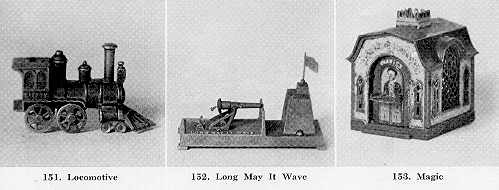
No. 151. Locomotive Savings Bank — A coin is dropped through a slot in top of cab and when full loosens the smoke stack. Semi-mechanical. The bank cannot be opened until filled with coin. Made entirely of iron and nickel plated. Words "Patented 1887" on side of cab. Originally you could have bought one dozen of these banks for just three dollars, but not now. $175.00
No. 152. Long May It Wave — A cannon and a parapet on a base about ten inches long. The cannon is mounted and you place the coin on the bar which holds up the end of the muzzle of the cannon and pull the trigger and the "ram rod" in the cannon shoots the coin into the circular hole in the recessed part of the parapet. On top is a U. S. metal flag. The words "Long May It Wave" on the top side of the base. $150.00
No. 153. Magic — One story bank building with sort of dormer roof effect. On either side a large latticed window. In front is the door which you pull open by the knob and there stands the cashier at a table or desk. You place the coin on this and press the lever on the outside wall and the door closes and coin is deposited inside. "Magic Bank" is up over the door and the word "Cashier" is on the inside of the door. Patented August 5, 1873 and March 7, 1876. $35.00
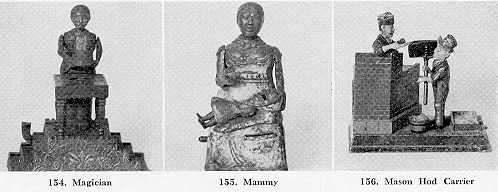
No. 154. Magician — A life like figure stands before a table four steps up a platform, upon which a coin is placed. By pressing a lever he lowers a high-hat over the coin, nods his head, and the coin disappears. Name "Magician Bank" on the front of platform. Stevens. January 16, 1882. (I like this bank). ($12.00 in 1939)
No. 155. Mammy and Child — Coin, which has been placed on a
large spoon held in colored mammy’s hand, is fed into the child’s mouth. When
lever is pressed child kicks feet
Mammy nods her head and feeds baby with a spoon. Has double coin entrance. One in
baby’s mouth and one in apron. Old catalogues advertised this as "Baby
Mine" bank. Painted in many colors. October 21, 1884. 306775. $60.00 ($20.00 in 1939)
No. 156. Mason and Hod Carrier — This represents a bricklayer laying brick. The hod carrier with his hod on his shoulder receives the coin in the hod, throws it forward depositing it in the bank. The mason raises and lowers the trowel and places the brick in position in a life-like manner. The name "Mason Bank on the base. February 8, 1887. Stevens. $65.00 ($15.00 in 1939)
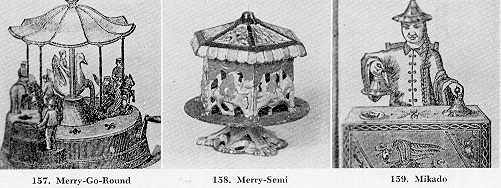
No. 157. Merry Go-Round — A replica of the old-fashioned merry go-round of Country Fair days, with five animals and their riders which merrily go round and round when wound up and coin inserted. A chime of bells rings. Small man stands on a platform with stick or whip in hand perhaps to push coin in but some say to whip the animals along. An old catalogue says: "Packed one in a wooden box, price $8.50 per Doz." (Compared with today’s prices we think that the price very reasonable indeed.) This is one bank that every collector dreams of getting in his collection sometime. $xxxxxx
No. 158. Merry Go-Round, Semi. — Revolves on fancy base. Tent-like top over the animals and riders. #-1/2" in diameter. Manufactured by the Grey Iron Casting Co., Columbia, Pa. $18.00
No. 159. Mikado — Chinaman seated behind large cabinet. Covers coin, like shell game. Place coin in recess in top of cabinet under cymbal in Mikado’s right hand and when crank is turned coin will disappear and reappear under cymbal in left hand. Chime of bells are heard when lever is pressed. The Bank is richly painted and decorated and packed each in a wooden box. Price $8.50 per doz. $xxxxxx
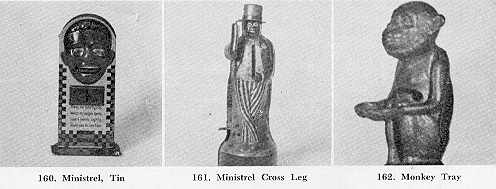
No. 160. Minstrel — Tin mechanical with wording: "Press the lever lightly, watch my tongue appear, Save a penny nightly, Make your fortune here." Press the lever and tongue comes out and eyes close. Place coin on tongue, push lever and coin disappears. Same construction, rather flimsy as the "Scotchman" and evidently made by same manufacturer. Also made without wording on it. $20.00
No. 161. Minstrel, Cross-Legged — Tin. A colored man elaborately dressed leans against a stump and graciously tips his high hat when the coin is placed in slot in his vest. He wears a red coat, full dress type, white vest and white and black striped trousers. $100.00
No. 162. Monkey — Sitting on his haunches with his hands outstretched in a manner that looks not unlike the apron or tray of a baby’s high chair. His arms rest on his knees and the coin is placed in his hands and as he raises them the coin slips into an opening in his stomach. One description says the bank is made of brass. November 7, 1882. d13400. $350.00
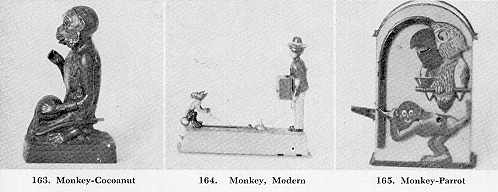
No. 163. Monkey and Cocoanut — Coin drops from the monkey’s hand into the cocoanut, which opens to receive it. Monkey also rolls his eyes and opens his mouth with a very life-like and amusing expression. Originally called the "Monkey Bank." March 2, 1886. 337125. Pat. by James H. Bowen. Stevens. $100.00
No. 164. Monkey and Organ Grinder — Modern. Coin is placed in the monkey’s mouth and when the spring is released the monkey jumps up on the grind organ and deposits the coin in the box. This is one of the three mechanicals banks still manufactured by the Hubley Mfg. Co., Lancaster, Pa. You can buy these banks at $1.25 each. $15.00
No. 165. Monkey and Parrot — Tin, 6 in. by 3-1/2 in. by 1-1/2 in. deep. The monkey is on the lower part of the bank in a stooped over position. You put the coin in its curled up tail, press down a lever and the coin rolls up over the back of the monkey into its outstretched paw and upon releasing the lever the coin shoots up into the parrot’s opened mouth. $100.00
